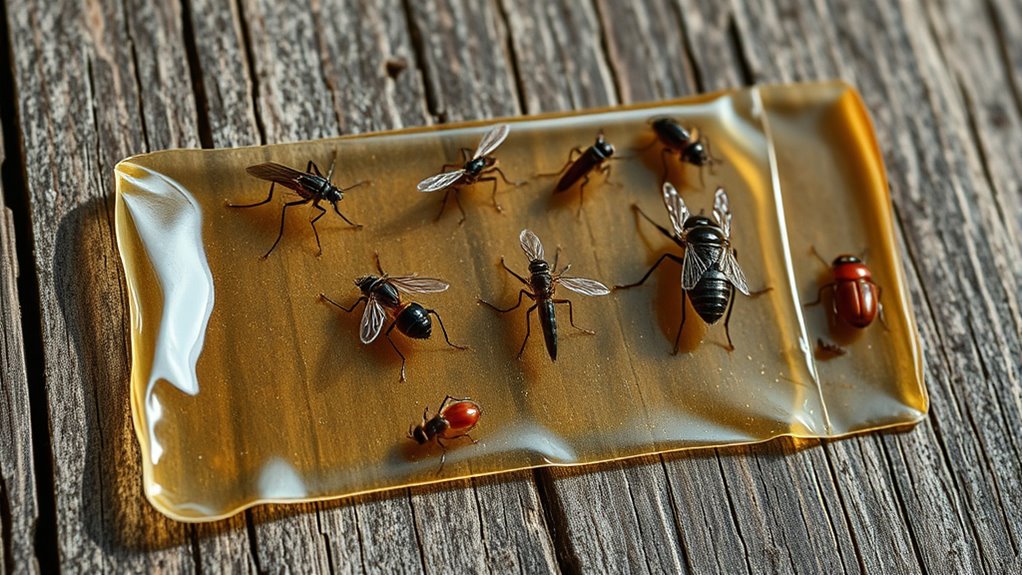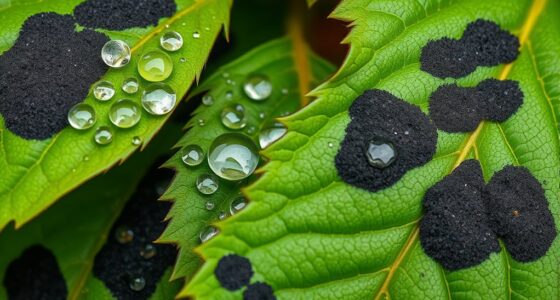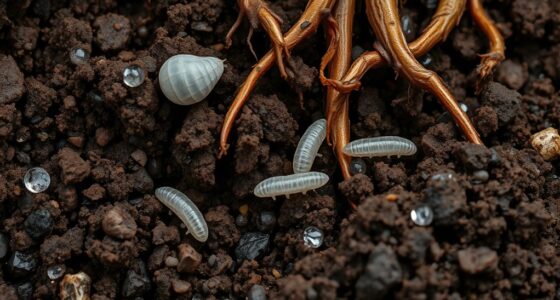Sticky traps reveal a lot about your pest populations, including which species are present, their activity levels, and behavior patterns. By counting and analyzing catches over time, you can identify hotspots, seasonal trends, or distinguish between resident and transient pests. Keep in mind that trap placement and attractants influence your data, and non-target captures can show broader ecosystem health. To get a clear picture and improve your pest control efforts, exploring further will provide valuable insights.
Key Takeaways
- Trap catches indicate the presence, abundance, and activity patterns of pest populations in specific areas.
- Consistent trap results help differentiate between resident pests and transient visitors.
- Fluctuations in catches over time reveal population trends and seasonal activity peaks.
- High counts near entry points suggest infestation hotspots requiring targeted intervention.
- Non-target species caught can provide insights into local biodiversity and ecosystem health.
Understanding the Types of Pests Captured
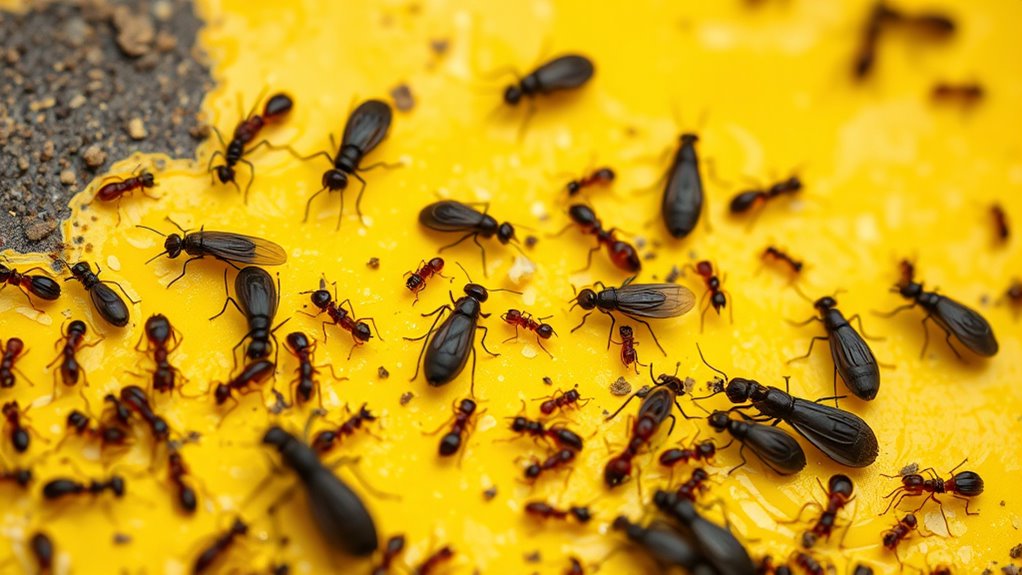
Understanding the types of pests captured by sticky traps is essential for effective pest management. By observing what gets caught, you gain insight into pest behavior, helping you identify their activity patterns and preferred habitats. Different pests respond to specific trap placements; for example, flying insects may be caught near windows or light sources, while crawling pests are often found along walls or baseboards. Recognizing these patterns allows you to position traps strategically, increasing their effectiveness. Knowing the pest types also helps you determine appropriate control measures once you identify the species. Monitoring what you trap provides valuable clues about the pests’ habits and populations, enabling you to tailor your approach and improve overall pest control success. Additionally, understanding projector contrast ratios can help you optimize your viewing environment, just as understanding pest behavior helps improve pest management strategies.
Counting and Analyzing Pest Numbers
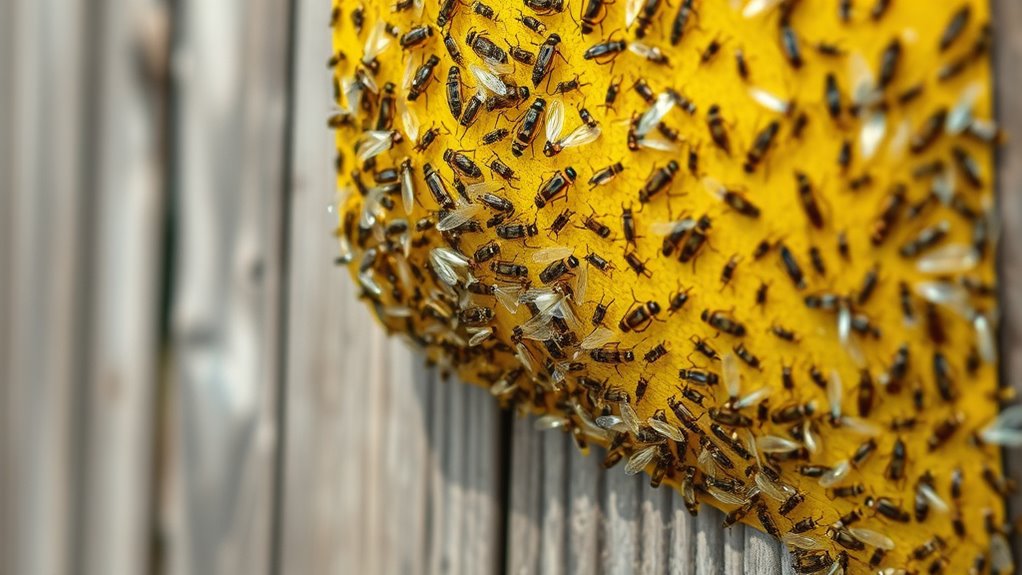
How do you accurately assess pest populations using sticky traps? First, observe pest behavioral patterns—when and where pests are active helps interpret trap catches. Effective trap placement strategies ensure consistent, reliable data. To analyze pest numbers, count the total catches and compare them over time, noting fluctuations that signal population changes. Here’s a quick guide:
| Trap Location | Pest Activity Level |
|---|---|
| Near entry points | High, indicates entry routes |
| Far from entry | Low, suggests containment |
This table helps identify hotspots and movement trends. Counting catches in different areas reveals pest behavior, guiding targeted control efforts. Regular analysis helps predict outbreaks and adjust placement strategies for better pest management. Incorporating monitoring tools like sticky traps enables more precise pest population assessments.
Identifying Patterns and Trends Over Time
Tracking pest catches over time reveals important patterns and trends that can inform your management strategies. By analyzing data from sticky traps, you can spot recurring fluctuations related to trap placement and seasonal variations. Recognizing these patterns helps you anticipate pest outbreaks, optimize trap locations, and plan timely interventions.
- Discover when pest activity spikes and prepare accordingly
- Understand how seasonal changes influence pest behavior
- Adjust trap placement to target emerging hotspots effectively
Monitoring these trends empowers you to stay ahead of pest populations, reducing damage and minimizing chemical use. Consistent observation allows you to fine-tune your approach, making pest management more efficient and less stressful. Staying alert to these patterns gives you the confidence to act proactively.
Differentiating Between Resident and Transient Pests

Differentiating between resident and transient pests is essential for effective pest management, as it helps you target your efforts more accurately. Resident pests tend to stay in one area, showing consistent pest behavior and often accumulating on sticky traps placed in their usual habitats. Transient pests, however, move through different spaces, making their presence more sporadic. To identify them, observe trap catches over time and note where they appear. Strategic trap placement is key: placing traps in core areas reveals residents, while sporadic captures in multiple locations suggest transient pests. Recognizing these patterns allows you to adapt your control methods, focusing on long-term solutions for residents and targeted actions for transient pests. Additionally, understanding pest behavior patterns can help you anticipate infestations and plan more effective interventions. This understanding improves your pest management efficiency and reduces unnecessary treatments.
The Significance of Non-Target Species

When non-target species get caught on sticky traps, you gain valuable insights into local biodiversity. These observations help you understand how different species interact within the ecosystem. Monitoring non-targets also signals the overall health and balance of the environment you’re managing. Recognizing the importance of ecosystem balance can guide more sustainable pest control practices.
Biodiversity Insights Gained
By capturing non-target species, sticky traps provide valuable insights into the broader ecosystem, revealing the diversity of organisms present in a given environment. This helps you understand pollinator diversity and how habitat fragmentation affects various species. Recognizing these patterns allows you to see the delicate balance of nature and the impact of environmental changes. When you observe a variety of non-pest species, you gain a deeper appreciation for ecosystem health and resilience. These insights can guide conservation efforts and pest management strategies that protect beneficial insects. Monitoring a range of species also highlights the importance of biodiversity in maintaining ecological stability and resilience.
Ecosystem Balance Indicators
Non-target species captured by sticky traps serve as essential indicators of ecosystem balance. By observing these catches, you can gauge the health of local biodiversity and understand urban pest dynamics more accurately. A high presence of beneficial insects suggests a stable environment, while a rise in non-target pests may signal ecosystem imbalance. Trap placement strategies matter; positioning traps thoughtfully helps you get a clearer picture of non-target species populations without disrupting the ecosystem. Monitoring these species helps you detect shifts in pest behavior and adjust control measures accordingly. Recognizing the significance of non-target captures allows you to balance pest management with conservation efforts, ensuring that your trapping efforts support ecosystem health rather than harm it. Additionally, understanding the vetted status of pest populations can guide more effective and environmentally responsible control strategies.
Using Trap Data to Detect Infestation Hotspots
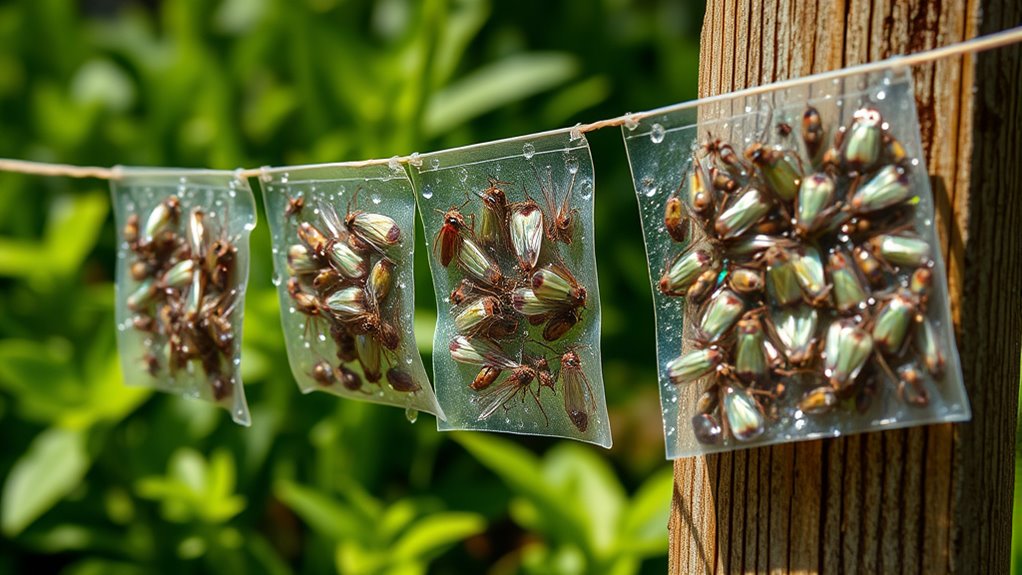
By analyzing trap data, you can identify areas with the highest pest activity, helping you focus your control efforts effectively. Tracking pest numbers over time also reveals trends that indicate emerging infestations or successful interventions. Using this information allows you to target hotspots and monitor the overall health of your pest management program. Additionally, understanding the behavioral patterns of pests can improve the accuracy of your detection and control strategies.
Identifying High-Activity Areas
Using trap data effectively allows you to pinpoint areas with the highest pest activity, which often indicate infestation hotspots. By analyzing where catches are most frequent, you can identify zones where pest behavior suggests a serious problem. Proper trap placement is vital—place traps near entry points, dark corners, or cluttered areas where pests hide and move. Spotting these high-activity areas lets you target your control efforts more efficiently, preventing a small issue from escalating. When you recognize pest hotspots early, you gain peace of mind, knowing you’re taking decisive action.
- Feel empowered as you take control of your space.
- Experience relief as infestations become manageable.
- Gain confidence in your pest management skills.
Monitoring Pest Trends
Monitoring pest trends over time helps you identify patterns that signal emerging infestation hotspots. By analyzing trap data, you can spot where pest activity is increasing, indicating potential trouble areas. Proper trap placement is essential; placing traps in strategic locations allows you to track pest migration and movement pathways effectively. Regularly reviewing catch counts helps you determine if pest populations are growing or shifting, enabling you to respond quickly. Tracking changes over weeks reveals trends that may not be obvious in a single snapshot, helping you anticipate outbreaks before they escalate. Consistent monitoring with well-placed traps gives you a clearer picture of pest behavior, so you can target control efforts precisely where they’re needed most. This proactive approach minimizes damage and keeps pests under control. Incorporating vertical storage solutions can also prevent pests from accessing certain areas, making your monitoring efforts even more effective.
Limitations of Sticky Trap Data
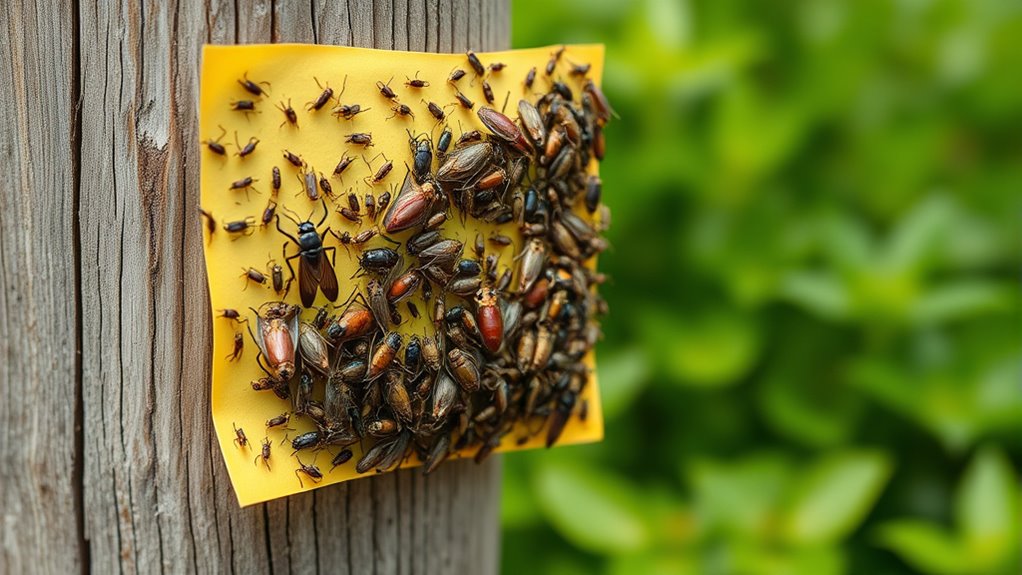
While sticky traps are valuable tools for evaluating insect populations, they come with notable limitations that can affect the accuracy of your data. Methodological biases, such as trap placement and attractant choice, can skew results. Sampling limitations mean you might miss certain pests or underestimate their numbers, especially if they’re not active during trapping periods. These factors can lead you to inaccurate conclusions about pest abundance and behavior. Additionally, understanding the nutritional content of attractants can help improve trap effectiveness and reduce biases.
Integrating Sticky Trap Results Into Pest Management Strategies
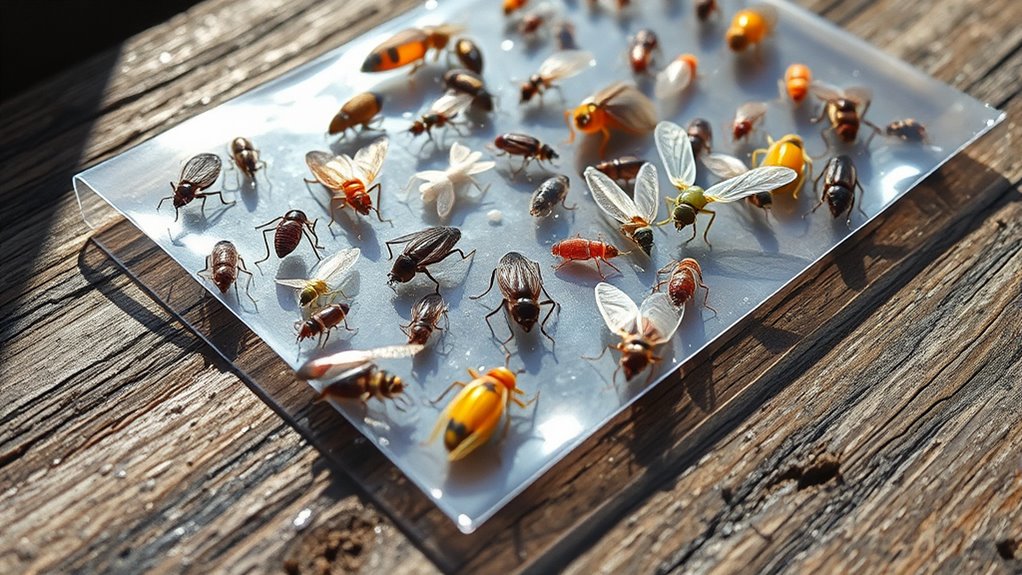
Integrating sticky trap results into your pest management strategies allows for more targeted and effective control measures. Start by regularly maintaining your traps—clean or replace them as needed to guarantee accurate data. Monitoring trap catches helps you identify pest population trends and peak activity times. Use this information to adjust bait selection, choosing attractants that are most effective for the pests in your area. Combining trap data with other control methods, like habitat modification or targeted pesticide application, enhances overall effectiveness. Remember to document your results and observe patterns over time. Properly diversify your control strategies to adapt to changing pest populations, informed by your trap data. This integrated approach ensures you’re responding precisely to pest activity, reducing unnecessary interventions and optimizing your pest management efforts.
Frequently Asked Questions
How Often Should Sticky Traps Be Replaced for Optimal Results?
You should replace sticky traps regularly to guarantee effective trap maintenance and accurate monitoring. Typically, check the traps weekly and replace them every 2 to 4 weeks, or sooner if they become full or dirty. Consistent replacement maintains their stickiness and visibility, helping you detect pest activity early. Adjust the replacement frequency based on pest levels and trap performance, ensuring ideal results in controlling and understanding pest populations.
Can Sticky Traps Attract Pests From Neighboring Areas?
Imagine a breeze carrying the scent of pests from neighboring areas, tempting them toward your traps. Sticky traps can indeed attract pests from neighboring pest influx, especially if trap attraction factors like scent or light draw in insects from nearby locations. While traps primarily catch pests already present, they may unintentionally pull in some from outside your property, highlighting the importance of strategic placement to minimize unwanted influx and maximize control.
What Environmental Factors Influence Trap Effectiveness?
Environmental factors like climate variations and trap placement greatly influence trap effectiveness. You’ll notice that temperature, humidity, and seasonal changes can affect pest activity and how they respond to traps. Proper trap placement is essential; placing traps near potential pest habitats or along movement pathways increases catches. By adjusting for these factors, you improve your chances of accurately monitoring pest populations and making informed control decisions.
Are Sticky Traps Safe for Domestic Pets and Children?
Think of sticky traps as tiny security fences. When placed carefully, they’re generally safe for pets and children, but you need to prioritize pet safety by placing traps out of reach. Proper trap placement guarantees curious pets don’t get stuck or exposed. Always check traps regularly, and use non-toxic traps if possible. With cautious placement and monitoring, you can keep pests under control without risking your loved ones’ safety.
How Do Sticky Traps Compare to Other Pest Monitoring Methods?
Compared to other pest monitoring methods, sticky traps are simple and effective. You place them strategically in areas with high pest activity, which allows for easy trap placement and pest identification. They provide visual evidence of pest presence, helping you track population trends over time. Unlike chemical methods, sticky traps are safe for your home, offering a non-invasive way to monitor pests and make informed control decisions.
Conclusion
Think of sticky traps as your pest detective’s toolkit, revealing hidden patterns and problem spots. By understanding what you catch, you can target infestations more effectively—like a flashlight illuminating dark corners. Remember, traps aren’t perfect, but they’re invaluable for tracking trends and making informed decisions. With careful analysis, you’ll stay one step ahead, turning pest management into a strategic game you’re always winning.
